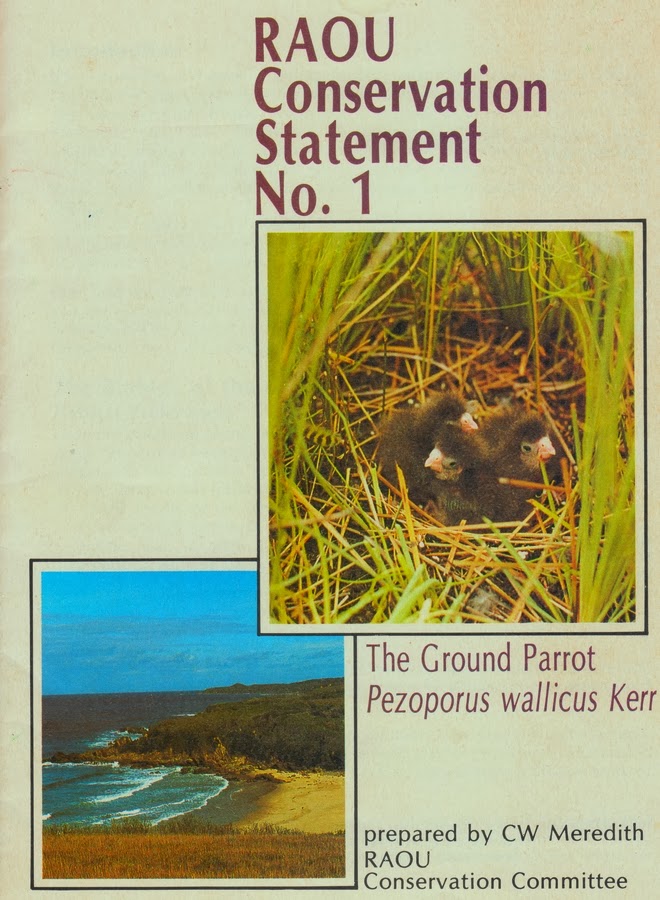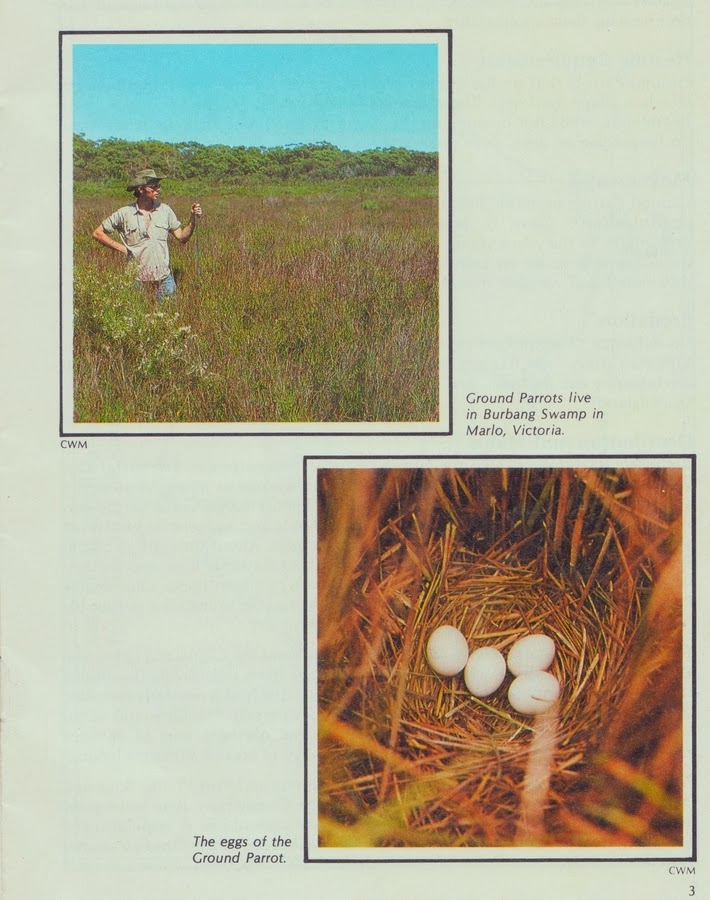Early in 1984, the Royal Australasian Ornithologists’ Union
(RAOU) published their first
Conservation Statement, called The Ground
Parrot. It was a quarto sized booklet of 12 pages and was mailed out to all
members as a supplement to the March news magazine as well as to bodies with
power to effect conservation measures. The author was C.W. Meredith, who had
been studying the Ground Parrot in Victoria since 1979 for various Victorian
Government departments so as to better manage this vulnerable species in that
state.
The publication proved to be a very valuable tool for those
who were trying to get some study done on the Ground Parrot in Western
Australia. A draft version of the Conservation Statement resulted in the
Department of Fisheries and Wildlife making some funding available to the RAOU,
leading to the first ever scientific
study of the species in Western Australia.
Salient extracts from the report are below. Highlighting has been added. The nest photos were very interesting and tantalizing to Western Australian bird watchers. Several, including Ray Garstone who was a very well-experienced nest finder, attempted to be the first to find a Ground Parrot nest in W.A. since Whitlock had in 1913, but without success.
The cover photos: Young Ground Parrots in the nest. (CWM)
Heath on the coast of East Gippsland - one of the habitats of the Ground Parrot (CWM)
South Australia. The Ground Parrot is now extinct in South Australia. It once ranged
along the coast from the Victorian border to Adelaide. Most populations became
extinct long ago due to clearing but parrots were still found around Port MacDonnell
and near the Victorian border until the 1940s and 50s. The last population, in
sedgelands behind coastal dunes near Nelson, died out in the 1950s when the
creek [the outlet of Ewens Ponds) that flowed through these sedgelands and into
the Glenelg River was diverted straight to the sea, and the sedgelands drained.
Western Australia. Next to South
Australia, the decline of the Ground Parrot has been most severe in Western
Australia. This is of particular significance as the Western Australian birds
are differentiated as a separate subspecies. Once distributed along the coast from north of
Perth to Cape Arid, the Ground Parrot is now only known from small, isolated
populations at Augusta, Fitzgerald River, Cape Arid and possibly, near Albany24. Very little is
known of the parrot’s habitat
requirements
in these areas, but the Fisheries and Wildlife Department have recently
provided funds to the RAOU for a survey of the Ground Parrot in the State25. Few of the known populations are in National Parks or reserves, and at least
one, near Fitzgerald River, is in an area proposed for clearing for agriculture.
Conclusions and
Recommendations
Since
European colonisation the Ground parrot has suffered a significant reduction in
range caused by clearing of its habitat. The main declines have been in western
Victoria, South Australia, Western Australia and the Bass Strait islands. In
eastern Australia, this phase is largely over, although some local populations
may still be in danger, but it is still continuing in Western Australia.
Heathland
populations make up the bulk of the present total population and are dependent
on a suitable fire regime for survival. Where burning is too frequent or too
long excluded these populations are endangered. In temperate heathlands a
minimum burning frequency of about once every fifteen to twenty years is recommended.
A frequency of ten to fifteen years may be suitable for sub-tropicalheathlands.
Burning in isolated areas should be planned bearing in mind the need to
maintain core populations to provide recolonisers.
Given that
present fire regimes in most parts of the parrot’s range are either (i)frequent
burns (fuel reduction burning, encouragement of “green pick”,for grazing, arson
and escapes from forestry activities) or (ii) very infrequent burns (total
protection with the occasional wildfire), active management of fire will be required
in most heathlands.
It must be
stressed that the Ground Parrot’s responses to fire have only been delineated
for temperate heathlands of types which occur in southern New South Wales, Victoria
and parts of Tasmania. and for sub-tropical heathlands in northernNew South
Wales and Queensland [preliminary work only]. Research is needed into
fire regimes suitable for populations in Western Australia and perhaps southern
Tasmania.
Much of the
Ground Parrot habitat that remains is reserved, either as National Park or as
Wildlife or Nature Reserves, though the adequacy of reserves in Western
Australia needs to be assessed. Very little active management is
undertaken in these reserves. Until this is done, more reservation will not
preserve the Ground Parrot.
A number of
currently endangered local populations require action. All Western Australian
populations urgently need to be located. censused and studied with a view to
producing a suitable management programme. Some may need to be incorporated
into reserves.
The Long
Swamp population in Victoria is small and isolated and its habitat wouldbe
endangered if there were any alteration in the water level of the Swamp. This needs
monitoring and may require management.
The Ground
Parrot's well developed dispersal ability suggests that its reintroduction to
some areas may be feasible, if the habitat can be restored. Recolonisation
could occur from nearby populations or birds could be released into isolated areas.
One possibility would be to re-establish a South Australian population by
re-directing the outlet from Ewens Ponds back to its original course
and
allowing sedgelands to redevelop around it.
Notes
1. Condon H. T. 1975. Checklist of The Birds of
Australia. Pt. 1. Non-Passerines. RAOU, Melbourne.
2. King, W. B. 1979. Red Data Book, Vol. 2. Aves.
IUCN, Switzerland.
3. A 15 month study of the Ground Parrot in
Victoria during 1979-80 by C. W. Meredith. A. M. Gilmore and A. C. Isles for
the Fisheries and Wildlife Division. The results are contained in an internal report
of the Ministry of Conservation: “A Study of the Ground Parrot (Pezoporus wallicus) in Victoria",
and in Meredith, C. W., A. M. Gilmore and A. C. Isles. in press. "The
Ground Parrot in south-eastern Australia - a fire-adapted species?” Aust.J.Ecol.
9.
A two
month study of the Ground Parrot at Wilsons Promontory by C. W. Meredith for
the National Parks Service in 1981. The results are unpublished.
A study of the bird in northern NSW coastal heaths
by A. M. Gilmore during 1981. Results not yet published but some conveyed to
the author by personal communication.
A three month study in 1983-84 by C. Meredith of
the parrot’s status and management needs in Victoria following the 1982-83
bushfires. Results presented in an unpublished report to the Fisheries and
Wildlife Division (Victoria) and the World Wildlife Fund (Australia).
4. Unless otherwise noted, the information in
this section is taken from the Ministry of Conservation (Victoria) Report (see
note 3).
5. The sedgeiands and the two temperate heathland
types have been characterised floristically and are described in detail in the
Ministry of Conservation report.
6. Personal communication from A. M. Gilmore;
personal observations of Queensland heaths by C. W. Meredith; discussion with C.
Sandicott and ]. Curnow, Queensland National parks and Wildlife Service.
7. See Newbey, K. and B., and K. Bradby. 1983.
Notes on the Swamp Parrot. WA Naturalist 15; 145-146.


No comments:
Post a Comment